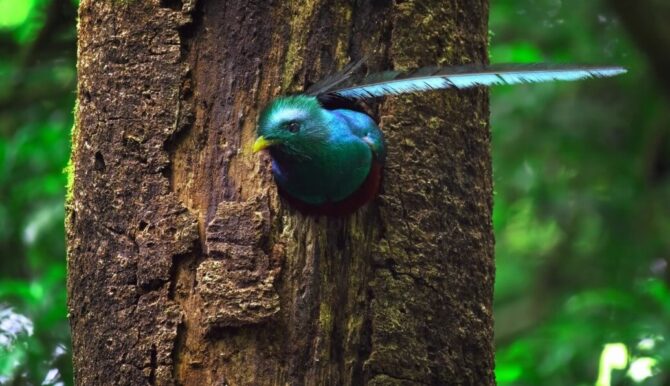From prehistoric times till now, many bird species have amazed people with their unusual features.
One such feature is the long neck. If you’re anything like us, long-neck birds get your interest and curiosity.
Just as other features serve to help the bird adapt to their environment, birds with long necks survive with those.
Some examples of birds with long necks are very common, like ostriches, the American flamingo, and different egrets. There are also some less common species, like the masked booby.
Here’s a list of 20 fascinating long-neck birds and some interesting facts you should know about them, with pictures.
Birds With Long Necks
1. Common Ostrich

- Scientific Name: Struthio camelus
- Length: 5 ft 7 to 9 ft 2 inches
- Weight: 139 to 320 pounds
- Range: Africa
The common ostrich is one of two ostrich species found in the genus Struthio, the other being the Somali ostrich.
This bird has a lot going for it, being the largest living bird, the fastest on land, and the biggest bird egg. The common ostrich is a native of Africa.
A feature you’d notice with ease on the ostrich is its long neck that looks like a snake on a plumage.
Its wings are also wide, which shouldn’t be surprising given that it’s a large bird.
As omnivores, the long neck serves to help it pick out berries, seeds, insects, and even smaller reptiles.
Combined with the strong beak and legs, the neck is also a form of self-defense.
2. American Flamingo

- Scientific Name: Phoenicopterus ruber
- Length: 47 to 57 inches
- Weight: 4.9 to 6.2 pounds
- Range: The Americas
As the name shows, the American flamingo is a native of the Americas, and it is the only flamingo that stems from North America.
It is a member of the Phoenicopteridae family and is also called the Caribbean flamingo.
It was once considered to be the same species as the greater flamingo, but that has since changed.
The American flamingo has as recognizable features the pink plumage, the long neck, and a broad beak.
As an omnivore that feeds on water-based products, the American flamingo captures prey using its long neck.
3. Sandhill Crane
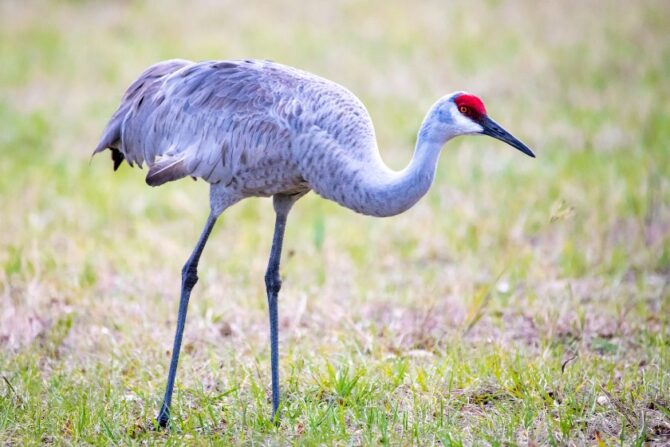
- Scientific Name: Antigone canadensis
- Length: 2 ft 7 to 4 ft 6 inches
- Weight: 6 to 14.8 pounds
- Range: North America, Siberia
The sandhill crane is a member of the Gruidae family, a large bird that lives both in North America and Siberia.
You’d often find this bird around coasts where it searches for food. There are currently six subspecies, including the lesser sandhill crane and the greater sandhill crane.
Its distinguishing features include long legs, grey plumage, a long beak, and an equally long neck.
It surveys the edges of water bodies looking for its next meal, and picks it out with the help of its neck and beak.
The sandhill crane feeds on small insects, reptiles, snails, and small berries.
4. Great White Egret
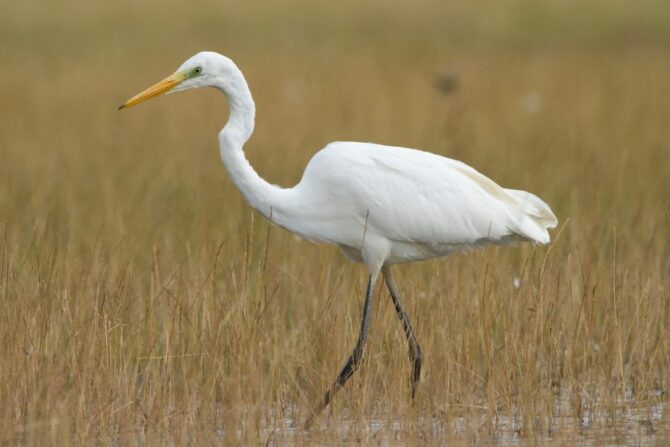
- Scientific Name: Ardea alba
- Length: 31 to 41 inches
- Weight: 1.5 to 3.3 pounds
- Range: Worldwide except for Australia and Antarctica
The subarctic great white egret is a member of the Ardeidae (heron) family, and its range is wild. It is found in every continent except Australia and Antarctica.
Alternative names of the great white egret include the great egret, the common egret, and the large egret.
This bird’s long neck is a recognizable trait, right after the white plumage that inspired the name.
It also has a yellow bill and black legs that distinguishes it from other white egrets.
Similar to the aforementioned birds, the great white egret’s neck helps it pick food.
5. Yellow-billed Stork
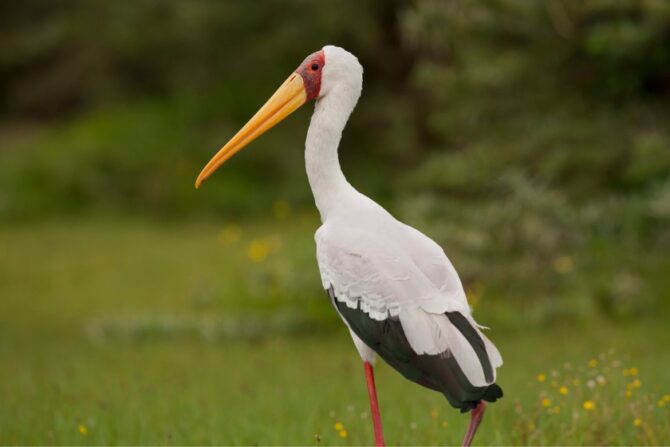
- Scientific Name: Mycteria Ibis
- Length: 35 to 41 inches
- Weight: 4.2 to 5.1 pounds
- Range: Africa
The yellow-billed stork is a member of the Ciconiidae family, and it is a native of Africa.
It is also named the wood stork or wood ibis. One country you’re sure to see this bird in is Madagascar.
It inhabits wetlands, lakes, swamps, and a few others. It is not particularly social but can regroup when food is nearby.
Prominent features of the yellow-billed stork are the long, yellow bill and an equally long neck. It feeds on small fish, worms, birds, aquatic insects, and small insects.
The yellow bill stork’s preferred method of eating is swallowing prey, and the long neck helps.
6. Scarlet Ibis
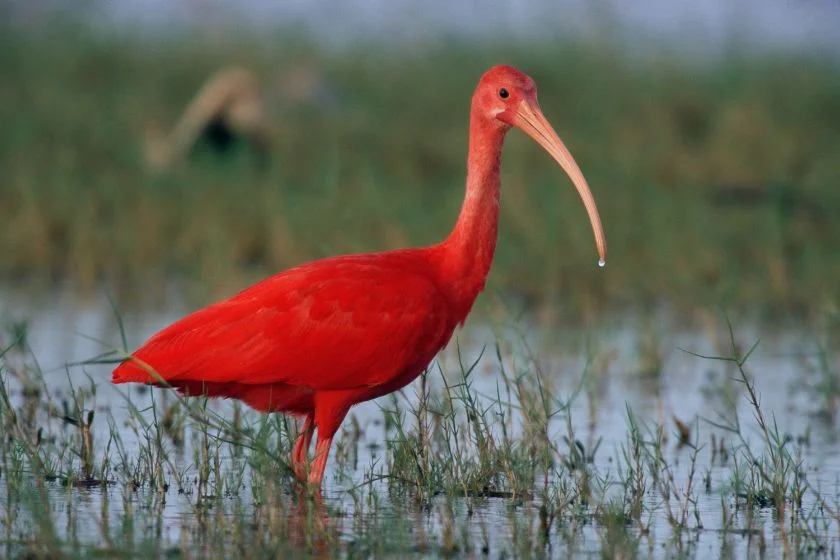
- Scientific Name: Eudocimus ruber
- Length: 22 to 25 inches
- Weight: 3.1 pounds
- Range: South America, The Caribbean
The scarlet ibis is a member of the Threskiornithidae family, and it is also called guará.
It is the national bird of Trinidad and Tobago, which falls within its range. The said range is both in South America and the Caribbean.
There have been calls to reclassify it as a subspecies of the more general American ibis, but that hasn’t happened.
The unmistakable trait of the scarlet ibis is its pink plumage, though as a juvenile its colors are grey, brown, and white.
The pink plumage comes as a result of the diet. Added to that is the long neck, another unmistakable trait.
Together with the beak, the scarlet ibis hunts while wading through the waters.
7. Cattle Egret
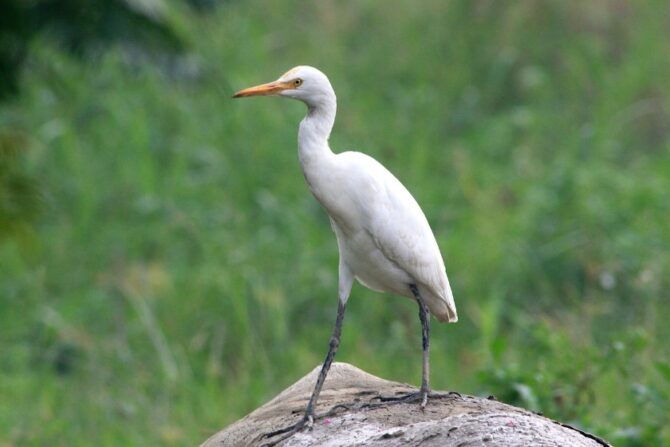
- Scientific Name: Bubulcus Ibis
- Length: 18 to 22 inches
- Weight: 9.5 to 18 ounces
- Range: Europe, Asia, Africa
The cattle egret is a part of the Ardeidae family alongside the great white egret and many other species.
There are two subspecies of cattle designated as western and eastern. Though some experts prefer to see both as separate species, the consensus leans otherwise.
The cattle egret’s neck can seem short and thick, but when erect it becomes quite long.
As the name shows, this bird can often be seen around cows as they wait for insects to eat. Cattle egrets and cows share a relationship known as commensalism.
8. Kori Bustard
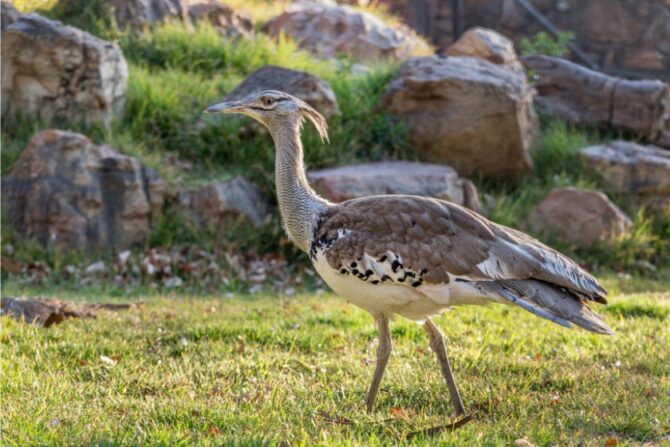
- Scientific Name: Ardeotis Kori
- Length: 3 ft 5 to 4 ft 5 inches
- Weight: 24 to 25 pounds
- Range: Africa, Australia, India
The kori bustard is a member of the Otididae family and is the heaviest flying bird that’s found in Africa.
Amongst the genus Ardeotis there are four species, all of which are heavy-bodied. The kori bustard dwells in savannas and grasslands.
Kori bustards have a long neck that compliments their thin legs and is very visible when on the ground.
Though this bird can fly, it hardly does so except when it needs to protect itself. Thus, its living condition is similar to that of non-flying big birds like the ostrich.
9. Black Swan
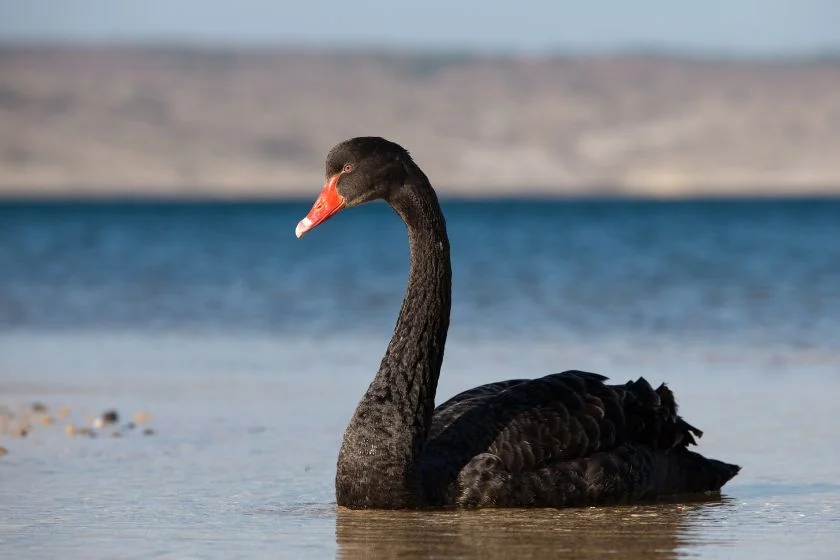
- Scientific Name: Cygnus atratus
- Length: 43 to 56 inches
- Weight: 8.2 to 19.8 pounds
- Range: Australia
The black swan is a member of the Anatidae family and is a nomadic creature in Australia.
You can also find it in New Zealand and a smaller population in New Guinea.
The conventional coat color of swans is white, and this immediately makes the black swan unique as it comes in complete black plumage.
The black swan has a large wingspan, a red beak, and a very long neck that extends as it flies.
Its diet is mainly herbivorous, consisting more of algae and weeds, which it needs its neck for. It gets its food from water bodies, which is where it often lives.
10. Bewick’s Swan

- Scientific Name: Cygnus bewickii
- Length: 45 to 59 inches
- Weight: 7.5 to 21.2 pounds
- Range: Artic tundra
The Bewick’s swan is a member of the Anatidae family, and it is sometimes regarded as the same species as the whistling swan under the name the tundra swan, though not always.
As the general name shows, this bird lives in the Artic and subarctic tundra. The Bewick’s swan has the conventional white color of swans.
Besides the color, this bird is recognized by its long neck and mixed-colored beak. It is a migratory bird, moving towards Siberia during the summer.
The Bewick’s swan feeds on aquatic plants during the summer and some other crops in different seasons.
11. Eurasian Spoonbill

- Scientific Name: Platalea leucorodia
- Length: 24 to 32 inches
- Weight: 3.7 to 4.4 pounds
- Range: Europe, Asia, and Africa
The Eurasian spoonbill is also called the common spoonbill, and it is a wading bird in the Threskiornithidae family that regroups spoonbills and ibises.
You’d often find it around marshes, swamps, and other forms of wetlands. Some birds are migratory; others are residents.
The Eurasian spoonbill’s name is inspired by the long, black beak shaped like a spoon. Its legs are also black, but besides those places, every other part is predominantly white.
This includes the long neck. The Eurasian spoonbill feeds mainly on aquatic animals like crustaceans.
12. White-faced Ibis

- Scientific Name: Plegadis chihi
- Length: 18.1 to 22.1 inches
- Weight: 15.9 to 18.5 ounces
- Range: The Americas
The white-faced ibis is another member of the Threskiornithidae family, just like the Eurasian spoonbill.
It is a native of the Americas, living in places like the United States, Mexico, Brazil, and Argentina. It can be found in marshes, where it breeds.
Just as the name implies, the white-faced ibis has a distinct white face, though, to be more specific, it is.
Its plumage is brown but can also be glossy. It sports both a long beak and a long neck.
13. Black-necked Stork
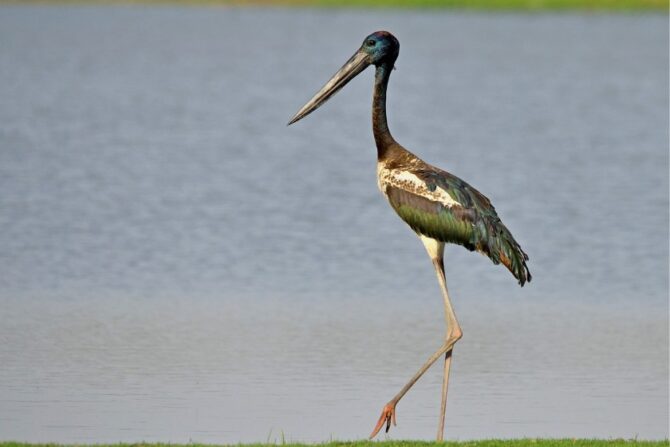
- Scientific Name: Ephippiorhynchus asiaticus
- Length: 51 to 59 inches
- Weight: 9 pounds
- Range: Southeast Asia
The black-necked stork is a member of the Ciconiidae family, and similar to other storks, it has an unusually long bill.
Its neck is quite long as well, and in addition to its legs, the bird is quite tall.
The black-necked stork is sometimes called the jabiru in Australia, though that name refers to another stork.
The long, black neck is the defining feature of this bird, as the name shows.
This comes in handy when the bird wants to feed on fish, crustaceans, and amphibians, among others.
14. Black-headed Heron
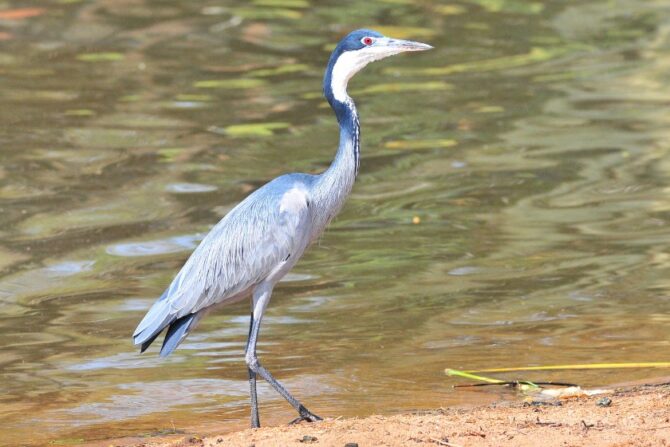
- Scientific Name: Ardea melanocephala
- Length: 33.4 inches
- Weight: 2.4 pounds
- Range: Africa
The Black-headed heron is a member of the Ardeidae family. It is a native of Africa, specifically the Sub-saharan region and Madagascar.
It is a large bird and is often compared to its relative, the grey heron.
Generally, the Black-headed heron is non-migratory. Some individuals are known to head up north in the rainy season, though.
This heron species is known by its black head, from which it got its name. The head sits atop a long, black neck, another one of its notable features.
The Black-headed heron gets its prey by stalking or ambush, and with the extended neck, it strikes easily at its next meal.
15. Dalmatian Pelican

- Scientific Name: Pelecanus crispus
- Length: 5 ft 3 to 6 ft inches
- Weight: 16 to 33.1 pounds
- Range: Europe
The dalmatian pelican is a member of the Pelecanidae family and is arguably the biggest freshwater bird.
We say ‘arguably’ because it has as competition some big swans. What is unarguable, however, is the elegance this bird possesses.
They move in flocks, and when flying they move in synchrony. The dalmatian pelican stays in Europe.
The hallmarks of this pelican are its white plumage, strong beak, and long neck. When perched, this neck is not always visible.
However, in flight, it often extends it. It feeds mainly on fish, grabbing it with the aid of its neck.
Related: Check Out These Birds That Look Like Dinosaurs
16. Mute Swan
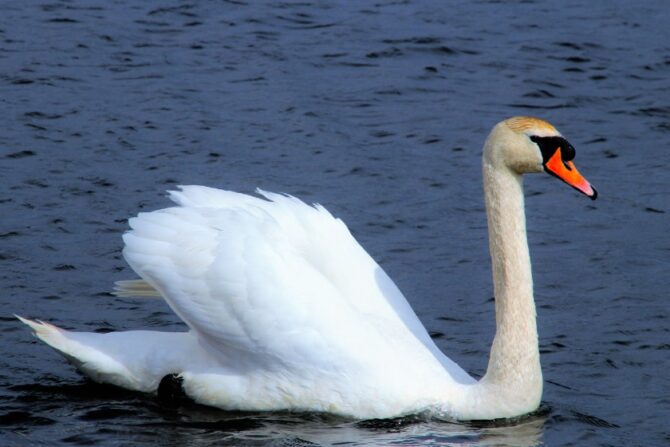
- Scientific Name: Cygnus olor
- Length: 49 to 63 inches
- Weight: 17 to 32 pounds
- Range: Eurosiberia
The mute swan has this interesting name because of how less vocal it is compared to other swans.
It is a member of the Anatidae family and is considered one of the heaviest-flying birds.
The mute swan is a native of the Eurosiberian region, but it can sometimes be found in Africa and North America.
It goes to Africa during the winter and was introduced in North America.
The mute swan has white plumage with an orange-black beak and a long neck. The neck helps it glide on the water and would also be outstretched as it flies.
17. Whooper Swan

- Scientific Name: Cygnus cygnus
- Length: 55 to 65 inches
- Weight: 16 to 31 pounds
- Range: Eurasia
The whooper swan (pronounced hooper) is an Anatidae bird that’s similar to the Bewick’s swan, another bird on our list.
It is usually found in Europe and Asia, though because of its migratory nature, its range can extend past that. The whooper swan often stays around water bodies.
Whooper swans have long necks that they tend to keep upright while walking.
Despite their size, they fly a lot. The necks often remain extended during these moments.
18. Snow Goose
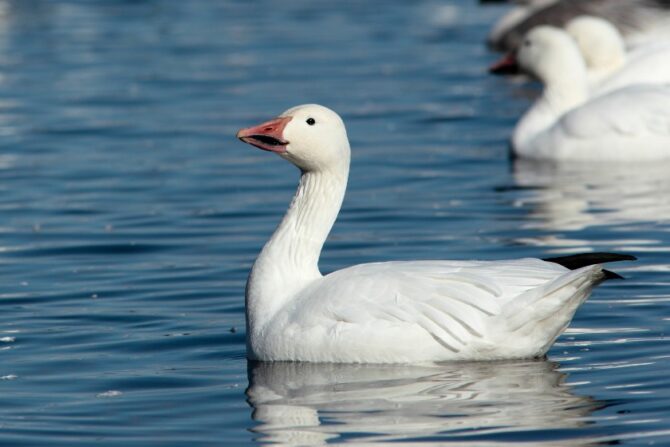
- Scientific Name: Anser caerulescens
- Length: 25 to 31 inches
- Weight: 4.5 to 9.9 pounds
- Range: North America
The snow goose is another member of the Anatidae family that lives in North America.
There are two color morphs of the species, the white and dark, the latter of which is called the blue goose.
It is also divided into two subspecies—the lesser and greater—with some variety in size.
Regardless of the color morph or subspecies, the snow goose comes with an outstretched neck. It stays in both water and land.
19. Roseate Spoonbill

- Scientific Name: Platalea ajaja
- Length: 28 to 34 inches
- Weight: 2.6 to 4 pounds
- Range: North America, South America
The roseate spoonbill is a member of the Threskiornithidae family, a relative of the Eurasian spoonbill.
It is a native of both North and South America. This bird is non-migratory, so you can expect to see it year-round.
In the United States, it dwells in Texas, Florida, and Louisiana.
The name is inspired by the rose color and the bill. The latter is shaped like a spoon, and the plumage is pink, a result of its diet.
It stays along shores and hunts down aquatic animals like fish and crustaceans.
20. Grey Heron

- Scientific Name: Ardea cinerea
- Length: 40 inches
- Weight: 2.4 to 4.9 pounds
- Range: Europe, Asia, Africa
The grey heron is a widespread Ardeidae species living in Europe, Africa, and Asia.
Because of its adaptability, it stays in different habitats close to water. In many places, the grey heron is a resident bird. However, the northern populations are known to migrate.
The grey heron’s long white neck is a hard miss as it stands protruded when you see it.
In addition to that, it also has an orange beak and grey wings that inspired its name. The grey heron feeds on sea creatures which it ambushes and catches.
Wrap Up
Birds have many notable features, and for the ones on our list, it is their long necks.
The majority of these avians often feed on water creatures—though not all do—and the neck serves to help them grab lunch.
The biggest among all the long-neck birds is the ostrich.



